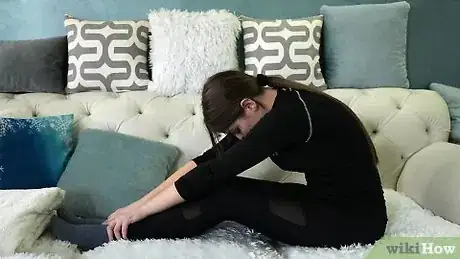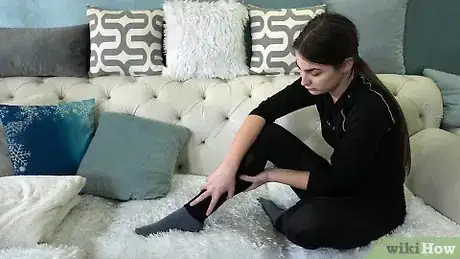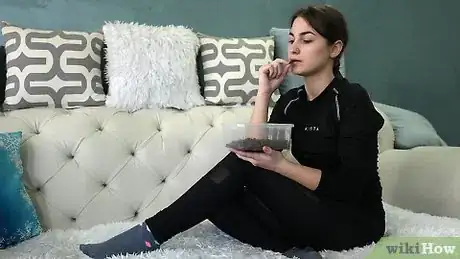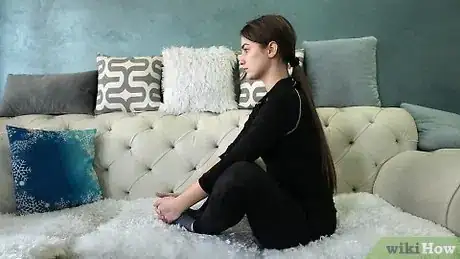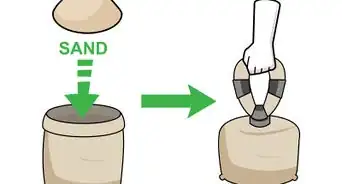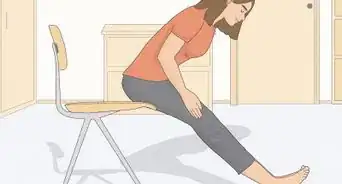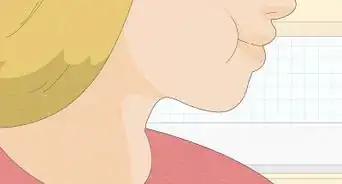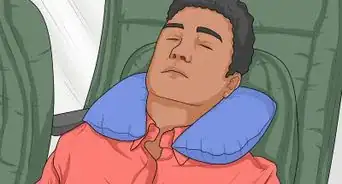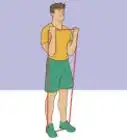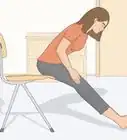This article was co-authored by Scott Anderson, MA, ATC, SFMA, DNSP and by wikiHow staff writer, Janice Tieperman. Scott Anderson is the Chief Clinical Officer at SyncThink, an award winning startup founded out of Stanford University. Scott previously served as the Director of Sports Medicine/Athletic Training for Stanford University for over ten years from 2007 to 2017. Scott has over 18 years of clinical and management experience, and is a recognized international speaker on topics of clinical specialization, which include developmental kinesiology, neuroscience/concussion, and movement dysfunction. He is a certified Dynamic Neuromuscular Stabilization Practitioner (DNSP), Sports Safety Specialist and is certified to conduct Selective Functional Movement Assessments (SFMA), and Functional Movement Screenings (FMS). He earned a BS in Athletic Training from Washington State University in 2000 and an MA in Athletic Administration from Saint Mary's College in 2002.
There are 12 references cited in this article, which can be found at the bottom of the page.
This article has been viewed 9,797 times.
After a hard run, your muscles are probably feeling the heat. Not to worry! There are plenty of easy, quick ways to cool down, stretch, and relax after your workout. Here are a few tips and tricks to help you get started.
Steps
Expert Q&A
Did you know you can get expert answers for this article?
Unlock expert answers by supporting wikiHow
-
QuestionHow can I make my muscles feel less stiff?
 Shira TsviShira Tsvi is a Personal Trainer and Fitness Instructor with over 7 years of personal training experience and over 2 years leading a group training department. Shira is certified by the National College of Exercise Professionals and the Orde Wingate Institute for Physical Education and Sports in Israel. Her practice is based in the San Francisco Bay Area.
Shira TsviShira Tsvi is a Personal Trainer and Fitness Instructor with over 7 years of personal training experience and over 2 years leading a group training department. Shira is certified by the National College of Exercise Professionals and the Orde Wingate Institute for Physical Education and Sports in Israel. Her practice is based in the San Francisco Bay Area.
Personal Trainer & Fitness Instructor
-
QuestionHow can I ease my muscles when they're stiff?
 Scott Anderson, MA, ATC, SFMA, DNSPScott Anderson is the Chief Clinical Officer at SyncThink, an award winning startup founded out of Stanford University. Scott previously served as the Director of Sports Medicine/Athletic Training for Stanford University for over ten years from 2007 to 2017. Scott has over 18 years of clinical and management experience, and is a recognized international speaker on topics of clinical specialization, which include developmental kinesiology, neuroscience/concussion, and movement dysfunction. He is a certified Dynamic Neuromuscular Stabilization Practitioner (DNSP), Sports Safety Specialist and is certified to conduct Selective Functional Movement Assessments (SFMA), and Functional Movement Screenings (FMS). He earned a BS in Athletic Training from Washington State University in 2000 and an MA in Athletic Administration from Saint Mary's College in 2002.
Scott Anderson, MA, ATC, SFMA, DNSPScott Anderson is the Chief Clinical Officer at SyncThink, an award winning startup founded out of Stanford University. Scott previously served as the Director of Sports Medicine/Athletic Training for Stanford University for over ten years from 2007 to 2017. Scott has over 18 years of clinical and management experience, and is a recognized international speaker on topics of clinical specialization, which include developmental kinesiology, neuroscience/concussion, and movement dysfunction. He is a certified Dynamic Neuromuscular Stabilization Practitioner (DNSP), Sports Safety Specialist and is certified to conduct Selective Functional Movement Assessments (SFMA), and Functional Movement Screenings (FMS). He earned a BS in Athletic Training from Washington State University in 2000 and an MA in Athletic Administration from Saint Mary's College in 2002.
Sports Medicine & Injury Prevention Specialist
-
QuestionHow can I make my body more relaxed?
 Scott Anderson, MA, ATC, SFMA, DNSPScott Anderson is the Chief Clinical Officer at SyncThink, an award winning startup founded out of Stanford University. Scott previously served as the Director of Sports Medicine/Athletic Training for Stanford University for over ten years from 2007 to 2017. Scott has over 18 years of clinical and management experience, and is a recognized international speaker on topics of clinical specialization, which include developmental kinesiology, neuroscience/concussion, and movement dysfunction. He is a certified Dynamic Neuromuscular Stabilization Practitioner (DNSP), Sports Safety Specialist and is certified to conduct Selective Functional Movement Assessments (SFMA), and Functional Movement Screenings (FMS). He earned a BS in Athletic Training from Washington State University in 2000 and an MA in Athletic Administration from Saint Mary's College in 2002.
Scott Anderson, MA, ATC, SFMA, DNSPScott Anderson is the Chief Clinical Officer at SyncThink, an award winning startup founded out of Stanford University. Scott previously served as the Director of Sports Medicine/Athletic Training for Stanford University for over ten years from 2007 to 2017. Scott has over 18 years of clinical and management experience, and is a recognized international speaker on topics of clinical specialization, which include developmental kinesiology, neuroscience/concussion, and movement dysfunction. He is a certified Dynamic Neuromuscular Stabilization Practitioner (DNSP), Sports Safety Specialist and is certified to conduct Selective Functional Movement Assessments (SFMA), and Functional Movement Screenings (FMS). He earned a BS in Athletic Training from Washington State University in 2000 and an MA in Athletic Administration from Saint Mary's College in 2002.
Sports Medicine & Injury Prevention Specialist Mindfulness and relaxation breathing techniques can promote recovery and relaxation in muscle tissue. A lot of people don't realize that stress, anxiety, and fatigue all lead to increased tension in our tissue. We have to be able to alleviate that tissue by clearing our mind. Things like pilates and yoga can also create a more relaxed physiology.
Mindfulness and relaxation breathing techniques can promote recovery and relaxation in muscle tissue. A lot of people don't realize that stress, anxiety, and fatigue all lead to increased tension in our tissue. We have to be able to alleviate that tissue by clearing our mind. Things like pilates and yoga can also create a more relaxed physiology.
References
- ↑ https://www.pennmedicine.org/updates/blogs/musculoskeletal-and-rheumatology/2017/february/injury-prevention-three-cool-down-steps-for-runners
- ↑ https://familydoctor.org/sore-muscles/
- ↑ https://familydoctor.org/the-importance-of-stretching/
- ↑ https://kidshealth.org/en/teens/stretching.html
- ↑ https://www.piedmont.org/living-better/the-5-most-important-post-run-stretches
- ↑ https://www.piedmont.org/living-better/the-5-most-important-post-run-stretches
- ↑ https://www.mayoclinic.org/healthy-lifestyle/fitness/multimedia/stretching/sls-20076840?s=5
- ↑ https://www.nhs.uk/live-well/exercise/how-to-stretch-after-a-run/
- ↑ https://www.piedmont.org/living-better/the-5-most-important-post-run-stretches
- ↑ https://www.nhs.uk/live-well/exercise/how-to-stretch-after-a-run/
- ↑ https://www.piedmont.org/living-better/the-5-most-important-post-run-stretches
- ↑ https://www.nhs.uk/live-well/exercise/how-to-stretch-after-a-run/
- ↑ https://www.piedmont.org/living-better/the-5-most-important-post-run-stretches
- ↑ https://www.nyrr.org/Run/Photos-And-Stories/2019/HSS-Ask-the-Experts-Ice-Baths
- ↑ https://www.bbc.com/news/health-17015767
- ↑ Scott Anderson, MA, ATC, SFMA, DNSP. Sports Medicine & Injury Prevention Specialist. Expert Interview. 24 March 2020.
- ↑ https://well.blogs.nytimes.com/2012/02/06/how-massage-heals-sore-muscles/
- ↑ Scott Anderson, MA, ATC, SFMA, DNSP. Sports Medicine & Injury Prevention Specialist. Expert Interview. 24 March 2020.
- ↑ https://www.mayoclinic.org/healthy-lifestyle/fitness/in-depth/exercise/art-20045506
- ↑ https://familydoctor.org/sore-muscles/
- ↑ https://familydoctor.org/sore-muscles/
About This Article
If your muscles are feeling tense or sore after a run, take 5-10 minutes to stretch your legs, which will help cool down and lengthen your muscles. Start by stretching your calves, which are often tight after running. Grab the back of a chair or put your hands against a wall for support, then take a step back with one foot, keeping both your feet flat on the ground. Bend your knees and move your hips forward until you feel a deep stretch in your calf. After about 30 seconds, switch legs. Next, bend one of your feet up and back, getting your heel as close to your butt as you can. Grab your foot with one hand and gently pull your leg up and back. This will help stretch out the quad muscles in your thigh. Again, hold that stretch for half a minute before you switch legs. To target your hip flexors, stand up straight and step forward with one foot, keeping both feet pointing forward. Bend the knee on your forward leg while keeping your back leg straight out behind you. Push your buttock on the back leg forward until you feel a nice stretch in your hip. Hold for 15 seconds, then switch to the other side. Move on to stretching the hamstrings in the backs of your thighs. To do this, put your hands on your hips and step forward with one leg. Keeping the leg straight, put your heel firmly on the ground and angle your toes up toward the ceiling. Bend your back leg slightly and slowly lean toward the side of your extended front leg. After 15 seconds, switch sides. For more expert tips, like how to soothe your muscles with a cool bath or a gentle self-massage, keep reading!
